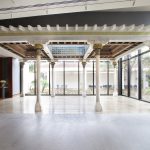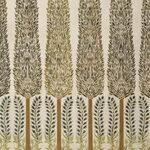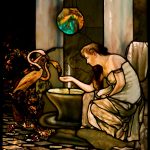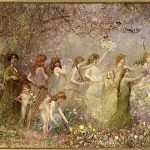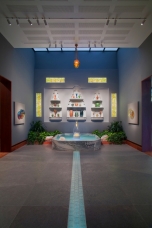The exhibition features the restored Daffodil Terrace and approximately 200 objects from or related to the estate. These include prize-winning leaded-glass windows, iconic Tiffany lamps, custom furnishings, as well as art glass and pottery in Tiffany’s personal collection.
The new Laurelton Hall galleries provide 6,000 square feet of additional public exhibition space and deepen the Morse’s interpretations of Tiffany’s life and legacy. Laurelton Hall, built between 1902 and 1905 and destroyed by fire in 1957, is arguably Tiffany’s greatest work of art. The artist directed every facet of the estate’s construction, from the room interiors and architectural details to an extensive scheme of gardens and fountains. In addition to the terrace, the 10 galleries at the Morse showcase surviving components of Laurelton Hall’s dining room, living room, and reception hall—also known as the Fountain Court—as well as other rooms, creating a uniquely immersive experience.
The Daffodil Terrace
The Daffodil Terrace, installed in a glass-enclosed gallery, is situated with a view of an expanded garden courtyard at the Museum and presented in a manner related to its original location at Laurelton Hall. The 18-by-32-foot outdoor terrace exemplifies Tiffany’s unique and dramatic style. Supported by eight 11-foot marble columns that are topped with bouquets of glass daffodils, the terrace’s coffered ceiling is composed of hundreds of stenciled wood elements and molded tiles in three bays. The central bay features a skylight covered by six large panels of iridescent-glass tiles in a pear-tree motif. The terrace, pieced together from more than 600 distinct parts and fragments, is the Museum’s most significant conservation project since reassembling Tiffany’s chapel interior from the 1893 World’s Columbian Exposition in Chicago.
Gallery Highlights
Highlights from the dining-room installation include: a 13.5-foot-high, mosaic-decorated marble mantelpiece that is one of Tiffany’s most forward-looking designs; a 25-foot-long Oriental rug; a domed leaded-glass chandelier 6.5 feet in diameter; and a suite of six leaded-glass Wisteria transoms. The living room installation showcases four leaded-glass panels depicting the four seasons—each from a single window displayed in the Tiffany exhibit at the Exposition Universelle in Paris in 1900, for which the artist won a gold medal. Five turtleback-glass hanging lamps suspended from an iron oxbow fixture made to the specifications of Tiffany’s original serve as the focal point for the gallery. The exhibit of objects from the Fountain Court includes the four-foot-high fountain vase that was its centerpiece as well as a millefiori blown-glass hanging shade. From the art gallery Tiffany built on the estate, the Morse is showing the pair of intricately carved Indian doors and half-moon-shaped peacock-feather window and glass mosaic that graced the entryway.
Hugh F. and Jeannette G. McKean rescued works from Laurelton Hall after the mansion was destroyed by fire in 1957. Over the next three decades the couple went on to assemble extensive holdings of Tiffany objects for the Morse—what is today the world’s most comprehensive collection of the artist’s work.
Cell Phone Audio Tour
The Museum is pleased to be able to provide visitors with a free audio tour of our Laurelton Hall exhibition that is accessible via cell phone. The 45-minute tour begins in the Laurelton Hall Introduction Gallery and ends in the Tiffany Chapel, with 27 stops at both objects and wall panels. It features a professional narrator along with commentary from Museum Director Laurence J. Ruggiero and Curator and Collection Manager Jennifer Perry Thalheimer plus audio clips from the late Hugh F. McKean, the Museum’s first director and an artist who studied at Laurelton Hall.




